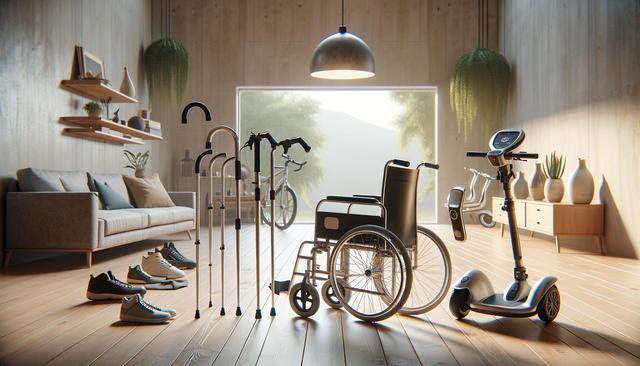
Affordable Mobility Aids for Any Lifestyle
Understanding the Importance of Mobility Aids
Mobility aids are essential tools that enhance independence, especially for individuals who face challenges with walking or maintaining balance. Whether due to aging, injury, or chronic conditions, many people find these aids to be life-changing. Affordable options are now more available than ever, making it easier to choose products that suit different lifestyles without a significant financial burden. Having the right mobility aid can make daily activities safer and more manageable, whether you’re navigating your home or venturing outside.
There are several categories of mobility aids, each designed to support specific needs. Common types include:
- Canes for minor balance support
- Walkers for more stability
- Wheelchairs for full sitting support
- Mobility scooters for longer distances
- Lift chairs to assist in sitting and standing
Choosing the right kind involves assessing your mobility level and environment. For example, a compact walker might be ideal for indoor use, while a foldable wheelchair could be better for those who travel often.
Cost-Effective Canes and Walking Sticks
Canes and walking sticks are among the most affordable mobility aids, and they serve as an excellent solution for individuals who need just a little extra support. They come in various styles, such as straight canes, quad canes, and folding models. The affordability of these items makes them accessible to a wide range of users, and they often cost less than many other mobility devices.
Features to consider when choosing a cane include:
- Adjustable height for proper posture
- Ergonomic handle design for comfort
- Non-slip rubber tips for better grip
- Foldable options for easy storage
Walking sticks are similarly useful, especially for those who hike or spend time outdoors. Some models include built-in lights or seats, adding convenience without drastically increasing the price. When selecting a cane or stick, ensure it supports your weight and is built with durable materials for long-term use.
Budget-Friendly Walkers and Rollators
Walkers and rollators offer more robust support than canes, making them ideal for individuals who need help with balance or fatigue. Walkers come in basic models without wheels, as well as advanced types with wheel attachments. Rollators add even more features such as brakes, seats, and storage compartments. Despite the added functionality, many budget-friendly options exist that provide reliable performance without high costs.
When comparing walkers, look for the following characteristics:
- Lightweight aluminum frames
- Foldable designs for portability
- Height adjustability
- Padded grips and seats for comfort
Rollators are especially helpful for outdoor use, where uneven surfaces can make walking tiring. Affordable models are available that still offer quality construction and practical features. These aids are ideal for those who want to stay active while managing limited mobility.
Accessible Wheelchairs for Daily Use
Wheelchairs are a crucial aid for those with limited lower-body mobility. While some models can be expensive, there are several affordable options designed for short-term use or daily activities. Manual wheelchairs, which require self-propulsion or assistance from a caregiver, tend to be more budget-friendly than powered models and can still provide excellent support and comfort.
Factors to consider when selecting an affordable wheelchair include:
- Seat width and weight capacity
- Ease of folding for transport
- Comfortable cushioning
- Durability of the frame and wheels
Some chairs are designed for occasional use, such as during outings or appointments, while others are built for daily use at home. Lightweight versions make it easier to move through tight spaces and reduce strain on caregivers. Even advanced features, like elevating leg rests or padded armrests, can be found in reasonably priced models.
Home Aids and Lifts to Improve Independence
In addition to aids for walking, there are also affordable solutions for moving around the home. Products like lift chairs, transfer boards, and grab bars can make a significant difference in daily routines. These tools help users transition from sitting to standing, move between rooms, and stay safe in areas like the bathroom or kitchen.
Some helpful and affordable home mobility aids include:
- Lift chairs with basic reclining features
- Bed rails for added safety at night
- Shower seats and grab bars for bathing
- Transfer benches for easier tub access
These devices are especially important for individuals who live alone or have limited caregiving support. Many of these aids are easy to install and designed with user safety in mind. With the right combination of tools, it’s possible to maintain independence and reduce the risk of falls or injuries at home.
Conclusion: Choosing the Right Aid for Your Needs
Affordable mobility aids can greatly improve the quality of life for individuals with limited mobility, regardless of their lifestyle. Whether you’re active and need support during long walks or require assistance moving around your home, there are cost-effective solutions available. By considering your specific needs and evaluating product features carefully, you can find a mobility aid that offers both value and support.
Mobility tools are not one-size-fits-all. It’s important to assess the environment, physical abilities, and personal preferences before making a choice. With a wide range of options—from canes and walkers to wheelchairs and home lifts—you can find practical support without exceeding your budget. Investing in the right mobility aid can help you or a loved one stay independent, safe, and confident each day.


